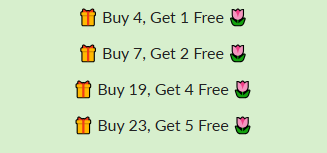Aster Formula Mixed Colors - Flower Seeds
Date prisa, la oferta finaliza en
 Non-GMO Seeds
Non-GMO Seeds
 100% Organic Seeds
100% Organic Seeds
 Money Back if Seeds Don’t Sprout
Money Back if Seeds Don’t Sprout
Want to fill your garden with love and warmth? Try planting love heart chrysanthemum seeds! These beautiful flowers have shapes and colors that are full of love, making them the perfect choice for showcasing your sincere emotions to family and friends.
Asters get their name from the Latin word for "star," and their flowers are indeed the superstars of the fall garden.
Not all asters are fall bloomers. Extend the season by growing some of the summer bloomers, as well. Some are naturally compact; tall types that grow more than 2 feet tall benefit from staking or an early-season pinching or cutting back by about one-third in July or so to keep the plant more compact.Aster is a genus of flowering plants in the family Asteraceae. Its circumscription has been narrowed, and it now encompasses around 180 species, all but one of which are restricted to Eurasia; many species formerly in Aster are now in other genera of the tribe Astereae.Asters are beautiful flowers that have lovely fringed petals. Some varieties of asters are annuals, but most asters are perennials, which means they come back year after year. Some asters look a lot like miniature daisies, and they are every bit as charming. Other varieties of asters have a single row of fringe-like petals. The petals of asters appear to be very delicate since they are narrow and fine, and although asters appear to be fragile flowers, there are very hardy varieties to choose from.Asters come in a wide variety of colors, and they are available in many different shades. You can find asters in various shades of pink, white, mauve, blue, purple, and red. There are numerous varieties and colors of asters, so you can be sure there are asters that will coordinate well with your unique garden or flower bed.Depending on the variety, asters grow to a height ranging between sixteen and twenty-four inches. Asters produce blooms for weeks at a time, and they are a wonderful choice for anyone wanting a beautiful flower that will create drama and add uncomparable beauty to their yard or garden.
Common Name:Michaelmas daisy, Aster
Height:up to 6 feet
Flower Colour:Violet flower
Bloom Time:Summer
Difficulty Level:Medium
Planting and care
Add a thin layer of compost with a 2 inch layer of mulch around the plants every spring
If you receive less than 1 inch of rain a week, remember to water your plants regularly during the summer
However, many asters are moisture-sensitive; if your plants have too much moisture or too little moisture, they will often lose their lower foliage or not flower well
Keep an eye out for any stressed plants and try a different watering method if your plants are losing flowers
Cut asters back in winter after the foliage has died
Divide every 2 to 3 years in the spring to maintain your plant s vigor and flower quality
Aster Formula Mixed Colors care
Asters are easily grown from division
Aster plants do best, if divided every two to three years
Simply dig out half to two thirds of the plants, leaving the remainder in place
Then separate the portion you dug out into two sections and plant in another location or give them to a friend
Aster seeds can also be directly seeded into your flower garden, or seeded indoors for transplanting later
We recommend planting Asters in pots and containers indoors, then transplanting the seedlings outdoors in early spring
This allows you to make the proper spacing
Sunlight:Select a site with full sun to partial sun.
Watering:Water plants in well. Soil should be moist, well-drained, and average to humus-rich.
Soil:Add compost or other organic material to your soil if necessary weeks in advance of planting your asters. Even if your soil is fine in texture, compost and organic material is beneficial to asters since it adds beneficial nutrients that will naturally enhance growth and improve the overall health of your asters.
Temperature:Asters prefer climates with cool, moist summers, especially cool night temperatures
Fertilizer:Fertilize soil prior to planting
Second:💰 Money-Back Guarantee: If you have any quality problems with the product within 30 days of purchase, we will gladly issue out a replacement or refund.
Third:✉️ Customer Support: We have a team of live reps ready to help and answer any questions you have within a 8-hour time frame, 5 days a week.
Fourth:🔒 Safe & Secure Checkouts: We use state-of-the-art SSL Secure encryption to keep your personal and financial information 100% protected.
Every shopping experience is a new experience full of expectations. If there are any problems with the seeds you received or the logistics process, please contact us by email first. We promise to follow up and handle it for you as soon as possible: whether you need to resend the goods or want a refund service, we will respond as quickly as possible. Your satisfaction is our primary pursuit!








